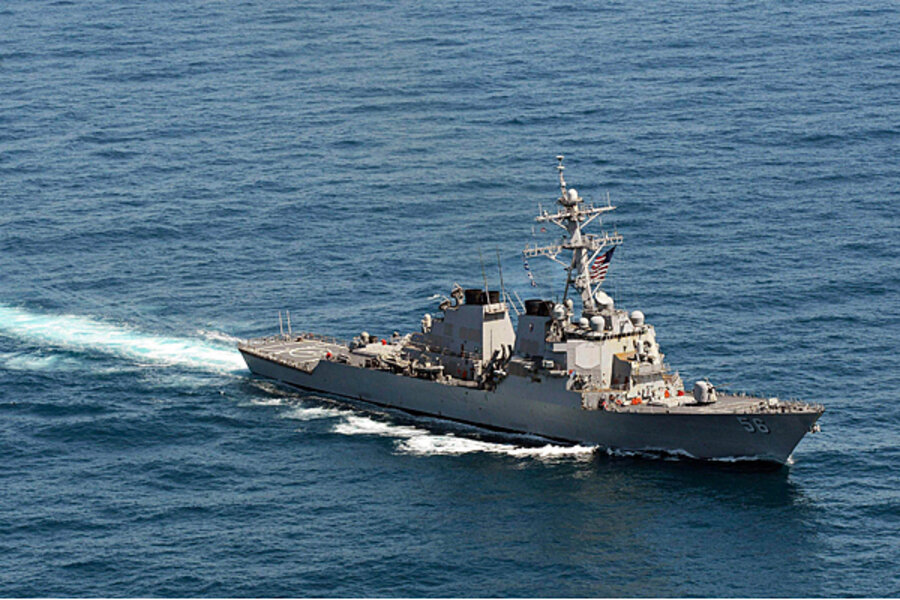North Korean missiles: Could US shoot them down?
| Washington
How capable are US missile defenses? That’s a key question for the United States and its allies as tensions remain bowstring tight on the Korean Peninsula. North Korea has moved several missiles – likely medium-range Musudans – to its east coast for possible test firing. Meanwhile, the Pentagon has deployed more missile-defense ground batteries and ships to the region, in part to reassure South Korea and Japan that Washington remains committed to their protection.
“We have demonstrated to the people of the region, demonstrated to the leadership of North Korea, our ability and willingness to defend our nation, our people, our allies, and our forward-deployed forces,” said Adm. Samuel Locklear, commander of US Pacific Command, during a Tuesday appearance before the Senate Armed Services Committee.
If Pyongyang decides to lob a short- or medium-range missile toward the Sea of Japan, could these US forces shoot it down? “Probably” is perhaps the best answer here. The systems involved are among the most mature of US missile-defense efforts. US officials point out that their recent test records have been reasonably good.
But some outside experts remain unconvinced that the US missile shield in this instance is that great.
“If the US tried to shoot down a test missile the intercept might succeed, mainly because in a test North Korea would presumably not seek to make any effort to evade the attempted intercept,” writes Tom Z. Collina, research director for Arms Control Association, in an e-mail. “But in a real missile attack North Korea could be expected to use decoys and countermeasures that US defenses would not be able to handle.”
Mr. Collina adds that shooting down a test missile headed to open ocean simply to prove that the US could do it would be “very provocative and ill-advised.”
Sen. John McCain (R) of Arizona urged just that on Monday, telling Foreign Policy blogger Josh Rogin, “If they launched a missile, we should take it out. It’s best to show them what some of our capabilities are.”
US missile defenses in East Asia are essentially a three-tiered system of systems.
The first line of defense would be Navy Aegis-equipped warships located in regional waters. The Aegis radar and fire control system can track ballistic missile targets during the mid-course portion of their flight. Its Standard Missiles are the latest version of a long-deployed weapon. They are designed to destroy missiles as high as outside the atmosphere via kinetic means. In other words, they just run into their targets.
Standard Missiles have successfully intercepted their targets in 25 of 31 attempts, according to a Congressional Research Service report on the system this year. Author Ronald O’Rourke notes, however, that some experts from outside the government have criticized the tests as unrealistic.
The second line of defense for some US forces would be the Terminal High Altitude Area Defense system (THAAD). This system is also hit-to-kill, aiming at targets as high as about 90 miles in altitude. Under development since the late 1980s, THAAD had teething problems, as early test flights were mostly misses. Tests undertaken since 2005 have been more successful.
THAAD is a point defense, meaning it attempts to shield a relatively small area against incoming missiles. The Pentagon has ordered a 95-person THAAD crew and its missiles to Guam to defend US bases there against any North Korean attack, although as of Monday it was unclear whether the crew had actually arrived.
Patriot missiles constitute the third layer of missile defense. These became famous as a point shield against Scud missiles during the Gulf War. Initial Army reports claimed a Patriot success rate of over 90 percent in that conflict; later analysis reduced that figure considerably.
Patriot defends against short- and medium-range missiles at lower altitudes than the THAAD system. The latest PAC-3 model, much faster and more maneuverable than early models, is designed to be hit-to-kill. It does contain a small explosive charge, however, that shoots fragments at incoming targets to increase lethality.
Today the Army has some 484 Patriot launchers, according to an Arms Control Association brief. The system has been bought by 13 other countries. These include South Korea and Japan, which on Monday deployed its PAC-3s to guard sensitive Tokyo sites.
THAAD and Patriot are limited in that they do not protect large areas, notes a lengthy 2012 National Research Council (NRC) study of US ballistic missile defense (BMD). Until recently, there were only limited attempts to get them and the Aegis system to work together.
But on the whole, all three systems are “well-developed” and suited to their individual missions, this study said.
The US appears “to be on the right track for developing BMD systems for countering short- medium- and intermediate-range ballistic missile threats from rogue states directed at the deployed forces of the United States and its allies,” the NRC concluded.
Of course, being on the right track may not be the same thing as being ready to handle any threat at the moment. And the NRC report was much more negative about another aspect of US missile defense: the effort to deploy ground-based interceptors in Alaska and Europe to protect the continental US from the still-developing threat of North Korean or Iranian intercontinental ballistic missiles.
The Pentagon recently said it would spend another $1 billion to deploy 13 more interceptors in California and Alaska to counter what it judges the growing North Korean missile threat.
This system is “very expensive” yet has “limited effectiveness,” said the NRC.






